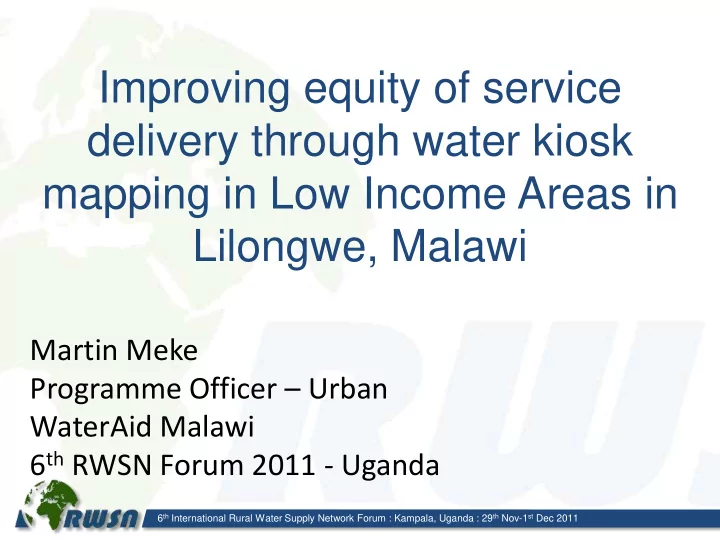

Improving equity of service delivery through water kiosk mapping in Low Income Areas in Lilongwe, Malawi Martin Meke Programme Officer – Urban WaterAid Malawi 6 th RWSN Forum 2011 - Uganda 6 th International Rural Water Supply Network Forum : Kampala, Uganda : 29 th Nov-1 st Dec 2011
Population density of Lilongwe 6 th International Rural Water Supply Network Forum : Kampala, Uganda : 29 th Nov-1 st Dec 2011
Situation • 650,000 people live in Lilongwe City. Over 60% living in Low-Income Areas (LIAs). • Water supply coverage = 85 – 98% for Urban areas in Malawi. • Number of existing kiosks – over 570; 480 in Lilongwe Water Board (LWB) billing system • Overwhelming number of users per kiosk in low- income areas • The Malawi Peri-Urban Water Supply and Sanitation project 6 th International Rural Water Supply Network Forum : Kampala, Uganda : 29 th Nov-1 st Dec 2011
Water Supply Challenges • Poor people double-charged for their water • Inadequate charging systems • Power and communities’ disillusionment • Vandalism of facilities • Lack of maintenance • Lack of transparency in billing • Inefficient billing system • No network monitoring system 6 th International Rural Water Supply Network Forum : Kampala, Uganda : 29 th Nov-1 st Dec 2011
Aims and objectives • Collect geo-referenced information from all water distribution kiosks across the LIAs in Lilongwe. • Establish a comprehensive assessment of the existing water supply services. • Compare service levels with population data and satellite imagery to measure water supply coverage and access. • Inform the planning process for the rehabilitation and equitable extension of water supply services through developing new kiosks. 6 th International Rural Water Supply Network Forum : Kampala, Uganda : 29 th Nov-1 st Dec 2011
Methodology • Data collection from all kiosks in LIAs – Functionality; Users; Management; Price • The information collected was encoded to the Spreadsheet Water Point Mapper • Maps were visualised in Google Earth 6 th International Rural Water Supply Network Forum : Kampala, Uganda : 29 th Nov-1 st Dec 2011
Results 1. New kiosk sites were determined: • To determine the location for new kiosks, a mapping function called the Acceptable Access Distance map was applied. • In the map, each water kiosk was represented with an icon depicting functional status and an opaque ‘sphere of influence’ surrounding each water point. • The radius of each sphere was set at 200-meters 6 th International Rural Water Supply Network Forum : Kampala, Uganda : 29 th Nov-1 st Dec 2011
Acceptable access distance 6 th International Rural Water Supply Network Forum : Kampala, Uganda : 29 th Nov-1 st Dec 2011
Community engagement 6 th International Rural Water Supply Network Forum : Kampala, Uganda : 29 th Nov-1 st Dec 2011
Water kiosk functionality Area name Total number Non functional % Non of kiosks kiosks functionality 39 9 7 77.8 Area 53 38 25 65.8 49 22 11 50 Area 44 10 5 50 56 98 38 38.8 24 36 8 22.2 6 th International Rural Water Supply Network Forum : Kampala, Uganda : 29 th Nov-1 st Dec 2011
Kiosk management systems Cumulative Management system Frequency Percent Percent WUA 319 57.3 57.3 Roman Catholic 3 .5 57.8 LWB/Dealer 179 32.1 89.9 LWB 28 5.0 95.0 LWB/CCODE 2 .4 95.3 Market centre committee 2 .4 95.7 Unity Youth Organisation 2 .4 96.1 Missing information 22 3.9 100.0 Total 557 100.0 100.0 6 th International Rural Water Supply Network Forum : Kampala, Uganda : 29 th Nov-1 st Dec 2011
Digital photographs 6 th International Rural Water Supply Network Forum : Kampala, Uganda : 29 th Nov-1 st Dec 2011
Project outputs So far: • 169 sites were identified, agreed with the community and approved by the water utility. • 27 kiosks and 12 tap stands have so far been constructed servicing close to 10,000 people in LIAs. • Additional 50 kiosks will be completed by the end of December 2011. 6 th International Rural Water Supply Network Forum : Kampala, Uganda : 29 th Nov-1 st Dec 2011
Issues to note • Some Google Earth images were not very clear due to clouds and shadows. This meant that some physical structures on the ground were obscured. • Downloading can be a problem if there are software/connectivity challenges. • The tool requires some form of literacy as to some the map is difficult to understand. - During site identification, some took time to appreciate the role of the maps. 6 th International Rural Water Supply Network Forum : Kampala, Uganda : 29 th Nov-1 st Dec 2011
Conclusions • Water point mapping provided an aerial view which helps to show distribution of water points in relation to physical development in the LIAs. • Provided an opportunity for using evidence in resource allocation and planning. • Ensure the database is kept updated and the maps are conveying an accurate picture of the reality of service delivery. 6 th International Rural Water Supply Network Forum : Kampala, Uganda : 29 th Nov-1 st Dec 2011
Thank-you Zikomo kwambiri Asante sana thank you!! 6 th International Rural Water Supply Network Forum : Kampala, Uganda : 29 th Nov-1 st Dec 2011
Recommend
More recommend